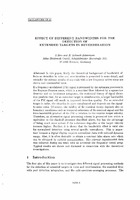| dc.contributor.author | Ries, S. | |
| dc.contributor.author | Schmidt-Schierhorn, H. | |
| dc.date.accessioned | 2018-10-11T14:05:47Z | |
| dc.date.available | 2018-10-11T14:05:47Z | |
| dc.date.issued | 1993/08 | |
| dc.identifier | 811 | |
| dc.identifier.govdoc | CP-42/2 | |
| dc.identifier.uri | http://hdl.handle.net/20.500.12489/144 | |
| dc.description.abstract | In this paper, firstly the theoretical background of bandwidth effects on detection in noise and reverberation is presented in some detail, and secondly the relevant results of sea. trials with a low frequency active sonar are shown and commented upon. If a frequency-modulated (FM) signal is processed by the optimum processor in the Neyman-Pearson sense, which is a matched filter followed by a square-law detector and an incoherent integrator, the statistical theory of signal detection predicts that, for an extended target in reverberation, a larger bandwidth of the FM signal will result in improved detection quality. For an extended target in noise, the situation is more complicated and depends on the signalto- noise ratio. Of course, the validity of the classical theory depends also on boundary conditions such as temporal coherence of the received signal and the time-bandwidth product of the FM in relation to the relative target velocity. Therefore, an alternative signal processing scheme is presented here which is equivalent to the classical processor described above, but has the advantage of being much more robust if the coherence degrades or the target velocity inceases higher. Further, it is shown that the bandwidth effect is valid also for normalized detection using several specific normalizers. This is important because a digital display requires normalized data with reduced dynamic range. Also, it is often desirable to obtain a constant false alarm rate which can be obtained by suitable normalization. The relevant experimental data was collected during sea trials with an activated low frequency towed array. Typical results are shown and discussed in connection with the theoretical investigations. | |
| dc.format | 23 p. : ill., 33 fig. ; digital, PDF file | |
| dc.language | English | |
| dc.publisher | NATO. SACLANTCEN | |
| dc.source | In: Low frequency active sonar (SACLANTCEN Conference Proceedings CP-42), vol. 2, 1993, pp. H/26-1 - H/26-23. | |
| dc.subject | Low Frequency Active Sonar (LFAS) | |
| dc.subject | Target detection | |
| dc.subject | Signal processing | |
| dc.subject | Ambient noise | |
| dc.subject | Acoustic reverberation | |
| dc.subject | Matched filtering | |
| dc.subject | Split-spectrum averaging | |
| dc.subject | Noise | |
| dc.title | Effect of different bandwidths for the detection of extended targets in reverberation | |
| dc.type | Papers and Articles | |
| dc.type | Conference Proceedings (CP) | |
